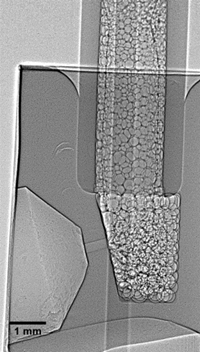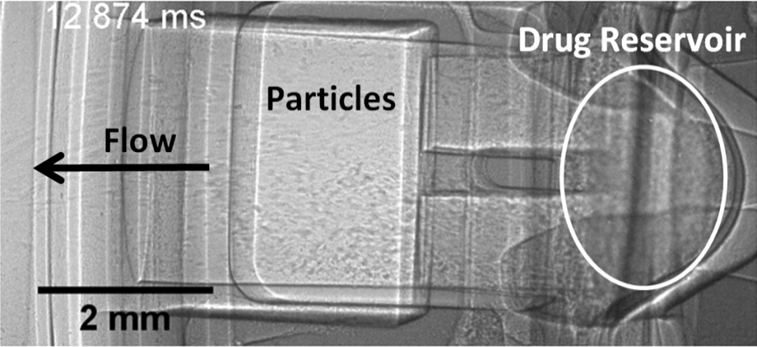- Home
- Industry
- Applications and case studies
- Health and Medtech
Health and Medtech
Every day we encounter health and medical technology, from devices and implants, to diagnostics, vaccines, drug delivery vehicles and devices. Understanding materials and their behaviour enables much of the modern applications of this technology. For example, materials research has allowed manufacturers to use new materials to improve the lifetime of implants. Through non-destructive analysis, the ESRF can investigate how materials behave under real conditions of end-use such as dental implants, drug delivery devices and pill design. Read more
The high quality and intensity of the ESRF X-ray beams allow researchers to study the micro- and even nano-structure of materials and devices. The techniques most widely used by this industry are X-ray radiography and 3D/4D computed tomography (CT) imaging. With suitable samples, these techniques can be performed with time resolution and under a wide range of environmental conditions. The ESRF can also provide comprehensive support for studies using animal models and longitudinal studies. Possible research includes:
- Characterisation of implant structures.
- Follow fatigue and ageing of implants.
- Structure and dissolution models of pills.
- Structure of drug delivery vehicles.
- Watch medical devices under operation.
Company or institute
Charité – Universitätsmedizin Berlin and Xploraytion GmbH
Challenge
Researchers had observed that bone cells near metal implants were less viable than native bone. They wanted to discover whether metal species from implants are present in bone and bone marrow adjacent to implants.
Sample
Samples were 10 μm sections of peri-implant cancellous bone including intertrabecular bone marrow from 14 patients with different loosened knee and hip implants. Controls were samples provided by other patients before receiving implants.
Solution
Synchrotron micro- and nano- X-ray fluorescence imaging (XRF) was used at beamlines ID21 and ID16B to qualitatively and quantitatively analyse the local toxicokinetics of released metallic wear and corrosion products and to identify their specific spatial distribution in bone and bone marrow. Beamline ID21 was used for micro imaging with a step size of 30 μm to define regions of interest and for quantitative XRF and XANES spectroscopy using between 10 and 2 μm resolution, while ID16B was used for nano spectroscopy, using a resolution of 60 nm.
Benefits
Particulate and non-particulate metals released from endoprostheses were found in abundance in peri-implant cancellous bone and intertrabecular bone marrow. The spatially-resolved elemental analyses of this study revealed the concentration, distribution, location, and accumulation of metallic degradation products in peri-implant bone and bone marrow. The researchers concluded that metals released from various implants lead to multi-elemental exposure in surrounding bone and bone marrow. They revealed that Cr accumulates in matrix structures of peri-implant bone marrow, Co and Cr integrate into the peri-implant cancellous bone and Ti particles were found predominantly in peri-implant regions of the bone marrow affected by fibrotic and inflammatory changes.
Reference
Metal-specific biomaterial accumulation in human peri-implant bone and bone marrow, J. Schoon, B. Hesse, A. Rakow, M.J. Ort, A. Lagrange, D. Jacobi, A. Winter, K. Huesker, S. Reinke, M. Cotte, R. Tucoulou, U. Marx, C. Perka, G.N. Duda, and S. Geissler, Adv. Sci. 2000412 (2020); DOI: 10.1002/advs.202000412.
This article was also featured by an ESRF News item: Metal particles of implants penetrate into the bone marrow.
Company
Prior PLM Medical, a company that specialises in supporting the medical and pharmaceutical industry to develop drug delivery devices from initial idea to end of product life.
Challenge
According to the World Health Organisation, over 300 million people worldwide suffer from respiratory diseases such as asthma and chronic obstructive pulmonary disorder (COPD). Inhaled medicine, typically in the form of pressurised metered dose inhalers (pMDI) and dry powder inhalers (DPI), is used to treat these diseases due to the direct delivery and reduced side effects. However, device/treatment efficacy is often quite poor with only 10-20% total lung deposition for most devices on the market.
The dynamics of the plume up to the point at which it exits the device are thought to influence speed and aerodynamic particle size distribution (APSD) and are considered important to drug transport to the lungs. However, this internal behaviour within the inhaler is not well understood due to the transient nature of the event and the difficulties in accessing the internal chambers within the device.
Sample
PMDI devices were investigated with a range of canisters, containing either HFA 134a or HFA 227ea propellants and various valve types, inserted into the actuator.
Solution
A monochromatic X-Ray beam was used at beamline ID19 at the European Synchrotron Radiation Facility. A Prior PLM Medical custom-built fixture was used to shake and actuate the inhalers. Phase contrast X-ray video of the dose release event from each inhaler showed the propellant mixture behaviour inside the canister and actuator. In addition mechanical interactions could be viewed taking place. This has provided new insights and is of value as a validation method for modelling efforts.
X-rays are capable of penetrating inhaler devices to visualise internal features but conventional techniques, for example industrial CT, are too slow to investigate fast events such as inhaler dose release. The ESRF beamlines have sufficient intensity to achieve the required temporal resolution and the phase contrast X-ray imaging technique gives excellent contrast for the low atomic number polymer/propellant/drug materials involved.
Benefits
“Our work at the ESRF has allowed us to see what’s happening inside both development stage and off-the-shelf commercial inhaler devices and has enabled our clients to make informed design decisions. We also use the facility for our own internal R&D programmes and are very excited by the prospect of the ESRF Extremely Brilliant Source.” Alan McKiernan, Research Manager Prior PLM Medical, physicist.
High speed X-Ray video of the dose release from a commercial Dry Powder Inhaler from Prior PLM Medical on Vimeo.
 |
 |
|
High speed phase contrast X-Ray imaging of dosing event in a pressurised Metered Dose Inhaler (left) and a Dry Powder Inhaler (right). |
|
Reference
Inhaler spray investigation using high-speed phase-contrast X-ray and Schlieren imaging, A.P. McKiernan, Pharmaceutical Research 36, 120 (2019); DOI: 10.1007/s11095-019-2657-9.




